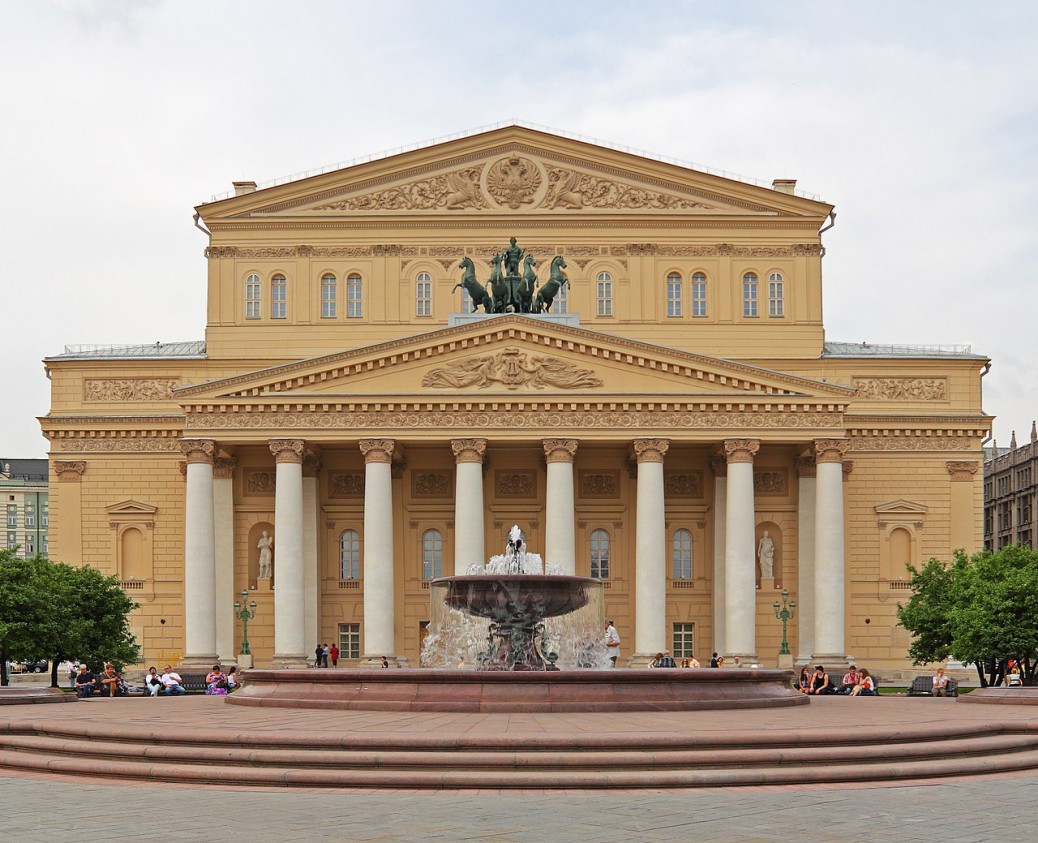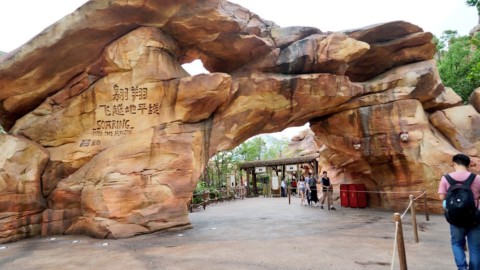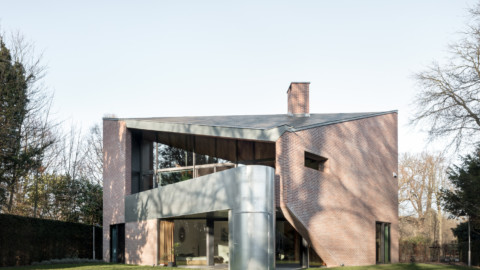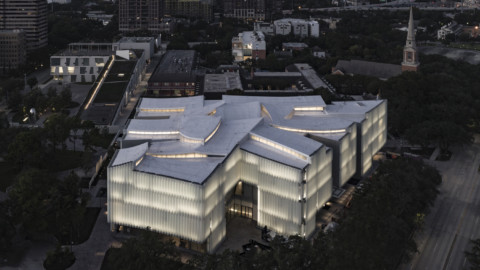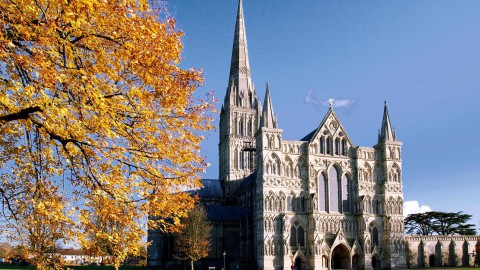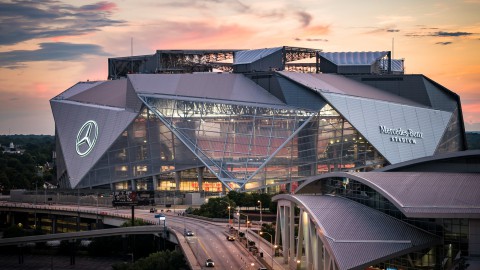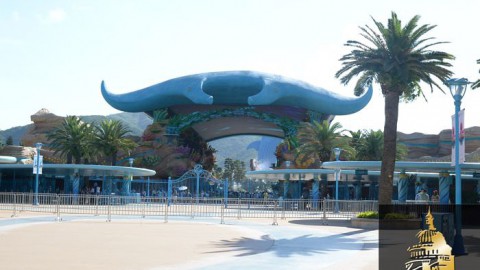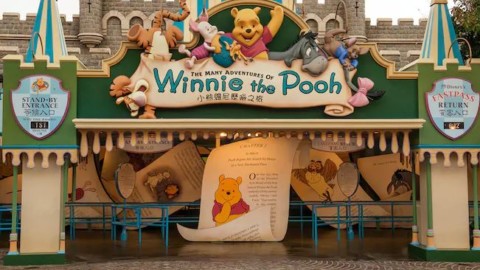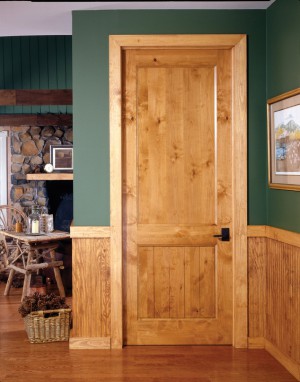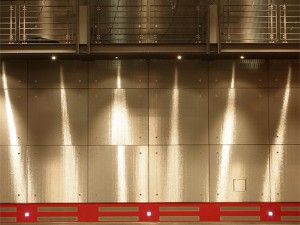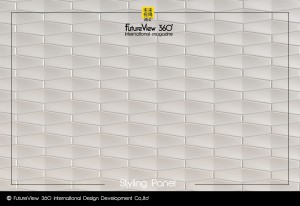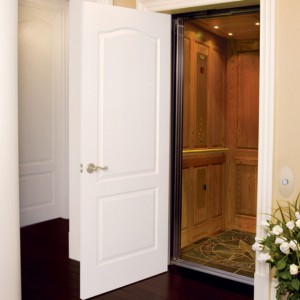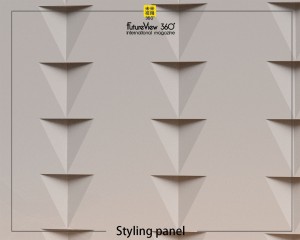Bolshoi Theatre 莫斯科大劇院
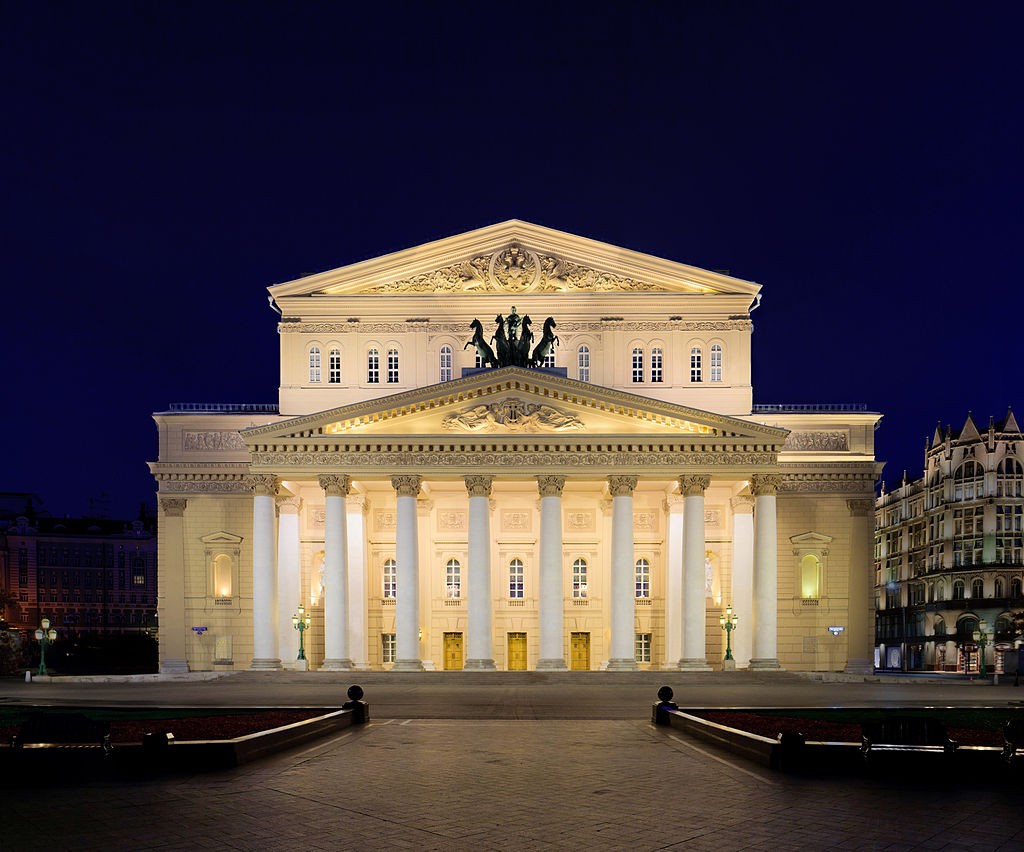
The Bolshoi Theatre (Russian: Большо́й теа́тр, tr. Bol’shoy Teatr, Big Theatre, IPA: [bɐlʲˈʂoj tʲɪˈatər]) is a historic theatre in Moscow, Russia, originally designed by architect Joseph Bové, which holds ballet and opera performances.[1] Before the October Revolution it was a part of the Imperial Theatres of the Russian Empire along with Maly Theatre (Small Theatre) in Moscow and a few theatres in Saint Petersburg (Hermitage Theatre, Bolshoi (Kamenny) Theatre, later Mariinsky Theatre and others).
The Bolshoi Ballet and Bolshoi Opera are amongst the oldest and most renowned ballet and opera companies in the world. It is by far the world’s biggest ballet company, with more than 200 dancers. The theatre is the parent company of The Bolshoi Ballet Academy, a world-famous leading school of ballet. It has a branch at the Bolshoi Theater School in Joinville, Brazil.
The main building of the theatre, rebuilt and renovated several times during its history, is a landmark of Moscow and Russia (its iconic neoclassical façade is depicted on the Russian 100-ruble banknote). On 28 October 2011, the Bolshoi re-opened after an extensive six-year renovation. The official cost of the renovation is 21 billion rubles ($688 million). However, other Russian authorities and other people connected to it claimed much more public money was spent. The renovation included restoring acoustics to the original quality (which had been lost during the Soviet Era), as well as restoring the original Imperial decor of the Bolshoi.
莫斯科大劇院(俄羅斯:Большойтеатр,tr.Bol’shoy Teatr,Big Theatre,IPA:[bɐlʲʂojtʲɪatər])是俄羅斯莫斯科的一座歷史劇院,最初由建築師JosephBové設計,負責芭蕾舞和歌劇表演。 1]在十月革命之前,它是俄羅斯帝國帝國劇院的一部分,還有莫斯科的馬利劇院(小劇院)和聖彼得堡的幾個劇院(冬宮劇院,莫斯科大劇院(後來到馬林斯基劇院等))。
莫斯科大劇院芭蕾舞團和莫斯科大劇院是世界上最古老,最著名的芭蕾舞劇和歌劇公司之一。它是迄今為止世界上最大的芭蕾舞團,擁有200多名舞者。劇院是莫斯科大劇院芭蕾舞學院的母公司,該學院是世界著名的芭蕾舞學校。它在巴西Joinville的莫斯科大劇院設有分校。
劇院的主樓,歷史上曾多次重建和翻修,是莫斯科和俄羅斯的標誌性建築(其標誌性的新古典主義外觀描繪在俄羅斯的100盧布鈔票上)。 2011年10月28日,Bolshoi經過長達六年的翻新後重新開放。翻新的官方成本是210億盧布(6.88億美元)。然而,其他俄羅斯當局和與之相關的其他人聲稱花費了更多的公共資金。翻新工程包括將聲學恢復到原始質量(在蘇聯時代已經丟失),以及恢復莫斯科大劇院的原始帝國裝飾。
Address :Teatralnaya Square 1
Tverskoy District, Moscow
Russia
Coordinates:55°45′37″N 37°37′07″ECoordinates: 55°45′37″N 37°37′07″E
Public transit:Teatralnaya or Okhotny Ryad (Moscow Metro)
Construction
Opened:1825
Architect:Peter Ouroussoff, Michael Maddox
地址:Teatralnaya Square 1
莫斯科Tverskoy區
俄國
坐標:55°45’37“N 37°37’07”ECoordinates:55°45’37“N 37°37’07”E
公共交通:Teatralnaya或Okhotny Ryad(莫斯科地鐵)
施工
開業時間:1825
建築師:Peter Ouroussoff,Michael Maddox
Origins
The company was founded on 28 March 1776, when Catherine II granted Prince Pyotr Urusov a licence to organise theatrical performances, balls and other forms of entertainment. Urusov set up the theatre in collaboration with English tightrope walker Michael Maddox. Initially, it held performances in a private home, but it acquired the Petrovka Theatre and on 30 December 1780, it began producing plays and operas, thus establishing what would become the Bolshoi Theatre. Fire destroyed the Petrovka Theatre on 8 October 1805, and the New Arbat Imperial Theatre replaced it on 13 April 1808, however it also succumbed to fire during the French invasion of Moscow in 1812.
The first instance of the theatre was built between 1821 and 1824, designed and supervised to completion by architect Joseph Bové based upon an initial competition-winning design created by Petersburg-based Russian architect Andrei Mikhailov that was deemed too costly to complete. Bové also concurrently designed the nearby Maly Theatre and the surrounding Theater Square, The new building opened on 18 January 1825 as the Bolshoi Petrovsky Theatre with a performance of Fernando Sor’s ballet, Cendrillon. Initially, it presented only Russian works, but foreign composers entered the repertoire around 1840.
起源
該公司成立於1776年3月28日,當時凱瑟琳二世授予彼得·烏魯索夫親王授權組織戲劇表演,舞會和其他形式的娛樂活動。 Urusov與英國走鋼絲的邁克爾·馬多克斯合作建立了劇院。最初,它在一個私人住宅舉行表演,但它收購了彼得羅夫卡劇院,並於1780年12月30日,它開始製作戲劇和歌劇,從而建立了什麼將成為莫斯科大劇院。火災於1805年10月8日摧毀了彼得羅夫卡劇院,1808年4月13日,新阿爾巴特皇家劇院取代了它,但在1812年法國入侵莫斯科期間,它也因火災而喪生。
劇院的第一個實例建於1821年至1824年之間,由建築師JosephBové根據彼得堡的俄羅斯建築師安德烈·米哈伊洛夫(Andrei Mikhailov)創建的最初競爭獲勝設計完成設計和監督,該設計被認為成本太高。 Bové還同時設計了附近的Maly劇院和周圍的劇院廣場。新建築於1825年1月18日開放,作為Bolshoi Petrovsky劇院,演出了Fernando Sor的芭蕾舞劇Cendrillon。最初,它只呈現俄羅斯作品,但外國作曲家在1840年左右進入曲目。
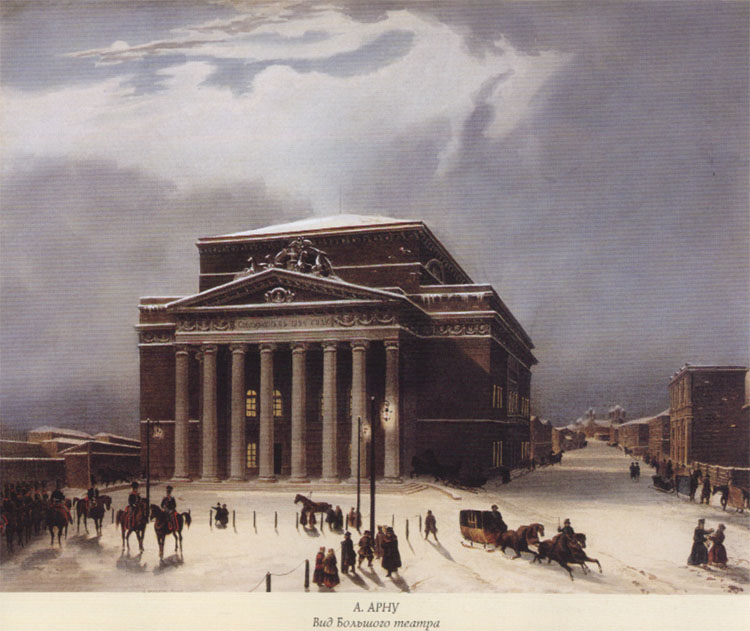
Renovations in the 19th century
In 1843 a large-scale reconstruction of the theatre took place using a design by A. Nikitin, but a fire in 1853 caused extensive damage and so a further reconstruction was carried out, by Alberto Cavos, son of the opera composer Catterino Cavos. On 20 August 1856, the Bolshoi Theatre reopened. Other repairs of the building took place in 1896.
19世紀的裝修
1843年,使用A. Nikitin的設計進行了劇院的大規模重建,但1853年的一場大火造成了巨大的破壞,因此歌劇作曲家Catterino Cavos的兒子Alberto Cavos進行了進一步的重建。 1856年8月20日,莫斯科大劇院重新開放。 該建築的其他維修工作於1896年進行。
20th century
On 7 December 1919 the house was renamed the State Academic Bolshoi Theatre. Only a few days later, however, on 12 December, there was an unsuccessful attempt to shut the institution entirely. Beethoven Hall opened on 18 February 1921. Ivan Rerberg directed further reconstruction of the theatre between 1921 and 1923. A bomb damaged the structure during World War II, but this was promptly repaired.
20世紀
1919年12月7日,這所房子改名為國立學術莫斯科大劇院。 然而,僅僅幾天之後,12月12日,完全關閉該機構的嘗試失敗了。 貝多芬音樂廳於1921年2月18日開幕。伊凡·雷伯格於1921年至1923年期間進一步重建了劇院。第二次世界大戰期間,一枚炸彈炸毀了該建築,但現在已經及時修復。
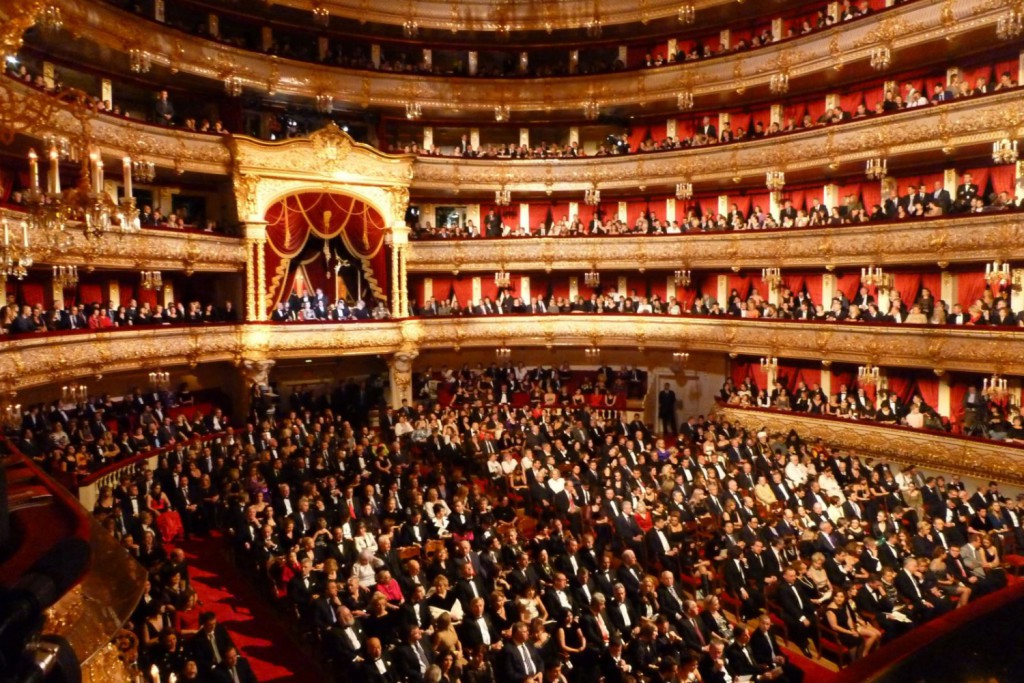
New stage of 2002
A new stage for the Bolshoi Theatre, called the New Stage, went into service on 29 November 2002, constructed to the left of the theatre’s historic main stage. Together with auxiliary buildings — a restored 17th-century building, two rehearsal halls, and artists’ recreation rooms — it forms a single theatre complex, the Bolshoi Theatre of Russia. The new building is on a natural hill which it shared, until recently, blocks of old houses with communal apartments.
2002年的新階段
莫斯科大劇院的新舞台,即新舞台,於2002年11月29日投入使用,建在劇院歷史悠久的主舞台左側。 與輔助建築 – 一座經過修復的17世紀建築,兩個排練廳和藝術家娛樂室 – 一起構成了一個單一的劇院綜合體,即俄羅斯莫斯科大劇院。 新建築位於一座天然山上,直到最近,它還與公共公寓共用。
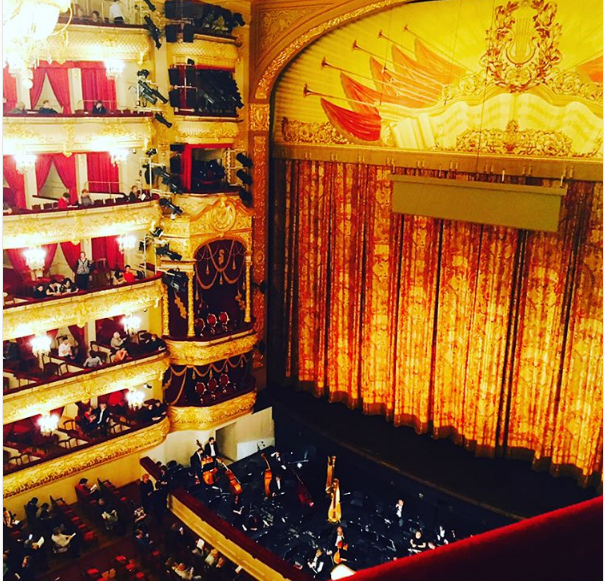
Major rebuilding and renovation (2005–2011)
From July 2005 to October 2011 the theatre was closed for restoration. It had undergone many renovations in its time, but none as extensive. The building, whose architecture combines three different styles, was damaged and a quick renovation seemed to be necessary.
Repairs were initially estimated at 15 billion rubles ($610 million) but engineers found that more than 75% of the structure was unstable, and as a result the cost estimate jumped to 25.5 billion rubles (app. $850 million). At the completion of the work, however, it was announced that only 21 billion rubles ($688 mil) had been spent. According to The Moscow Times, the true cost may have been double that, and Der Spiegel quotes a figure of $1.1 billion. The rebuilding and renovation was funded entirely by the federal government.
During the long period of reconstruction, the company continued to mount productions, with performances held on the New Stage and on the stage of the Great Kremlin Palace.
The renovation included an improvement in acoustics, to attempt to replicate the sound believed to have existed in pre-Soviet times, and the restoration of the original Imperial decor. The building’s foundation and brickwork were thoroughly reset. Inside, the entire space was stripped from the bottom up. The 19th-century wooden fixtures, silver stage curtain and French-made red velvet banquettes were removed for repair in specialist workshops. Outside, on the top of the façade, the double-headed eagle of the original Russian coat of arms was installed in the place where the Soviet hammer and sickle had been mounted for decades.
Finally, on 28 October 2011, the Bolshoi Theatre re-opened with a concert featuring international artists and the ballet and opera companies. The first staged opera, Ruslan and Lyudmila, followed soon after.
重大改建和翻新(2005-2011)
從2005年7月到2011年10月,劇院關閉進行修復。它在當時經歷了許多翻新,但沒有一個如此廣泛。該建築結合了三種不同的風格,已經損壞,似乎需要快速翻新。
最初估計維修費用為150億盧布(6.1億美元),但工程師發現超過75%的結構不穩定,因此成本估算躍升至255億盧布(約8.5億美元)。然而,在完成這項工作後,宣布僅花費了210億盧布(6.88億美元)。根據“莫斯科時報”的報導,真正的成本可能是兩倍,而Der Spiegel引用的數字為11億美元。重建和翻新完全由聯邦政府資助。
在長期的重建期間,公司繼續製作製作,在新舞台和大克里姆林宮的舞台上舉行表演。
翻新工程包括改善聲學效果,試圖複製蘇聯時代曾經存在過的聲音,以及恢復原有的帝國裝飾。建築的基礎和磚砌工作徹底重置。在裡面,整個空間從底部向上剝離。 19世紀的木製裝置,銀色舞台幕布和法國製造的紅色天鵝絨長椅在專業工作室中被拆除進行維修。外面,在正面的頂部,原始俄羅斯徽章的雙頭鷹安裝在蘇聯錘子和鐮刀已安裝數十年的地方。
最後,2011年10月28日,莫斯科大劇院重新開放,舉辦了一場以國際藝術家,芭蕾舞和歌劇公司為主題的音樂會。不久之後,第一部歌劇“魯斯蘭”和“柳德米拉”緊隨其後。
![]()
FROM:https://en.wikipedia.org/wiki/Bolshoi_Theatre
FROM:360 video: Unique Bolshoi Theatre VR tour.
Don’t you think it’s addictive?
Want to know more about the beauty of architecture?
Come and join our members to explore the beauty of architectural design.
覺得看得不過癮嗎?
想要知道更多建築之美嗎?
快來加入我們的會員,一同探索建築設計之美。
The above article is purely for appreciation and sharing purposes, as well as the construction of new technology and the public can be in-depth understanding of the information at the same time there are sources, will be able to query, no use of the document as a commercial transaction, if illegal, please inform the We will immediately remove the site, thank you for cooperation.
以上文章純粹作為欣賞及分享用途,以及將建築新型技術傳遞給與大眾能夠深入了解,同時資料還有來源,將可查詢,絕無使用該文件資料作為商業交易行為,如有違法請務必告知該網站我們將立即處理撤除,謝謝合作。

